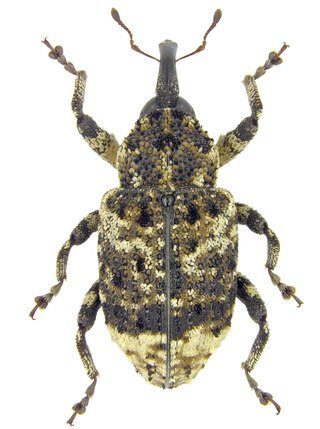
Cryptorhynchinae is a large subfamily of weevils (Curculionidae), with some 6000 species. They are found in most zoogeographic regions although they are most diverse in the Neotropics, Australia and Oceania.

Hadramphus tuberculatus is a rare weevil endemic to Canterbury in the South Island of New Zealand. It was thought to be extinct in 1922 but was rediscovered in 2004.

Gymnopholus is a genus of beetles in the family Curculionidae occurring in New Guinea. Many of them are notable for the growth of algae, diatoms, fungi, lichens and mosses on their backs(especially the subgenus Symbiopholus). The genus is divided into two subgenera and contains the following species:

Trigonopterus is a genus of flightless weevils placed in the Cryptorhynchinae of Curculionidae. It is distributed in Australia, Indonesia and Melanesia. About 90 species had been formally described until March 2013, when a single paper more than doubled this number, agreeing with previous studies and a systematic barcoding study that many more species have yet to be described. As of October 2021, there were 480 described species.

Barystethus tropicus is a species of the true weevil family.

Entimus is a genus of broad-nosed weevils belonging to the family true weevil and the Entiminae subfamily.

Ithystenus wallacei is a species of straight-snouted weevils belonging to the family Brentidae.

Eustylini is a primarily Neotropical weevil tribe in the subfamily Entiminae.

Geonemini is a weevil tribe in the subfamily Entiminae.

Asytesta is a genus of beetles belonging to the family Curculionidae.

Tranes is a genus of true weevils in the beetle family Curculionidae. There are about 11 described species in Tranes.
Neoerethistes is a genus of true weevils in the beetle family Curculionidae. There are more than 30 described species in Neoerethistes. The only species in North American north of Mexico is Neoerethistes arizonicus, found in the southwestern United States.
Isodacrys is a genus of broad-nosed weevils in the beetle family Curculionidae. There are 20 described species in Isodacrys, ranging from the southern United States of America to Honduras.
Othippiini is a tribe of true weevils in the beetle family Curculionidae. Of the eight genera in Othippiini, only Egiona and Othippia are not monotypic. Acoptus suturalis is the only species of the tribe found in the New World.
Egiona is a genus of true weevils in the beetle family Curculionidae. There are at least three described species in Egiona.
Othippia is a genus of true weevils in the beetle family Curculionidae. There are more than 20 described species in Othippia.

Barystethus is a genus of the true weevil family.

Brachyolus is a genus of broad-nosed weevil in the family Curculionidae.
Strattis biguttatus, is a species of weevil found in Indian subcontinent.

Polyteles is a South American genus of broad-nosed weevils in the subfamily Entiminae, tribe Entimini. There are seven described species distributed in Argentina, Bolivia, Brazil, Ecuador, Paraguay, Peru, and Uruguay.













